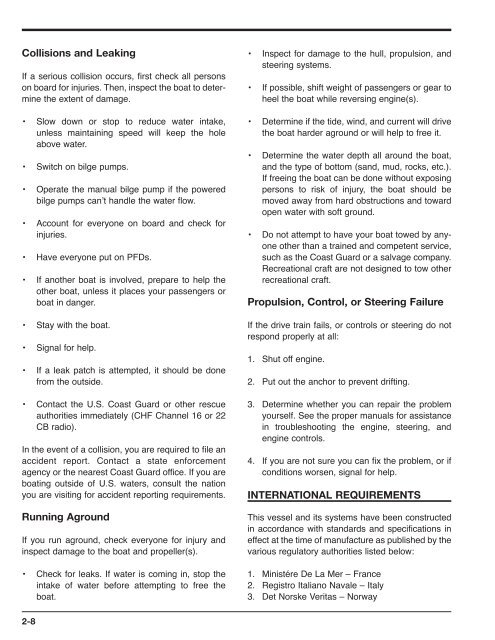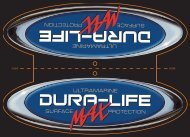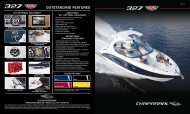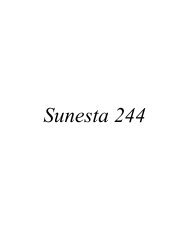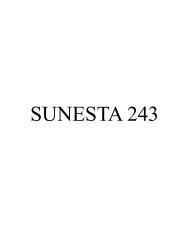OWNER'S/OPERATOR'S MANUAL - Chaparral Boats Owners Club
OWNER'S/OPERATOR'S MANUAL - Chaparral Boats Owners Club
OWNER'S/OPERATOR'S MANUAL - Chaparral Boats Owners Club
Create successful ePaper yourself
Turn your PDF publications into a flip-book with our unique Google optimized e-Paper software.
Collisions and leakingIf a serious collision occurs, first check all personson board for injuries. Then, inspect the boat to determinethe extent of damage.• Slow down or stop to reduce water intake,unless maintaining speed will keep the holeabove water.• Switch on bilge pumps.• Operate the manual bilge pump if the poweredbilge pumps can’t handle the water flow.• Account for everyone on board and check forinjuries.• Have everyone put on PFDs.• If another boat is involved, prepare to help theother boat, unless it places your passengers orboat in danger.• Stay with the boat.• Signal for help.• If a leak patch is attempted, it should be donefrom the outside.• Contact the U.S. Coast Guard or other rescueauthorities immediately (CHF Channel 16 or 22CB radio).In the event of a collision, you are required to file anaccident report. Contact a state enforcementagency or the nearest Coast Guard office. If you areboating outside of U.S. waters, consult the nationyou are visiting for accident reporting requirements.running agroundIf you run aground, check everyone for injury andinspect damage to the boat and propeller(s).• Check for leaks. If water is coming in, stop theintake of water before attempting to free theboat.• Inspect for damage to the hull, propulsion, andsteering systems.• If possible, shift weight of passengers or gear toheel the boat while reversing engine(s).• Determine if the tide, wind, and current will drivethe boat harder aground or will help to free it.• Determine the water depth all around the boat,and the type of bottom (sand, mud, rocks, etc.).If freeing the boat can be done without exposingpersons to risk of injury, the boat should bemoved away from hard obstructions and towardopen water with soft ground.• Do not attempt to have your boat towed by anyoneother than a trained and competent service,such as the Coast Guard or a salvage company.Recreational craft are not designed to tow otherrecreational craft.Propulsion, Control, or steering FailureIf the drive train fails, or controls or steering do notrespond properly at all:1. Shut off engine.2. Put out the anchor to prevent drifting.3. Determine whether you can repair the problemyourself. See the proper manuals for assistancein troubleshooting the engine, steering, andengine controls.4. If you are not sure you can fix the problem, or ifconditions worsen, signal for help.inTernaTional requireMenTsThis vessel and its systems have been constructedin accordance with standards and specifications ineffect at the time of manufacture as published by thevarious regulatory authorities listed below:1. Ministére De La Mer – France2. Registro Italiano Navale – Italy3. Det Norske Veritas – Norway2-8


